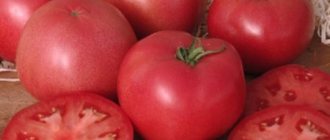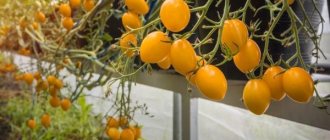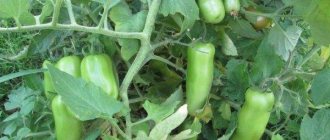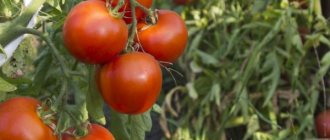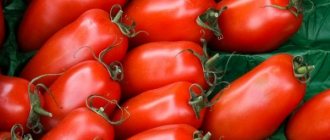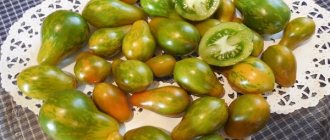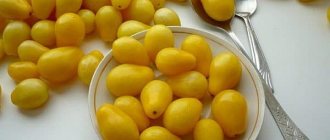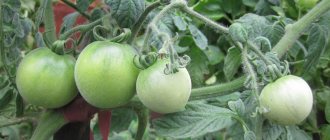Description of the tomato variety “Golden Drop”
“Golden Drop” is a classic indeterminate variety. Its bushes are spreading, have significant foliage and have a well-developed root system. The height of the plant can reach 2 meters. Up to 12 fruits ripen in one fruit cluster.
Fruit
The appearance of the tomatoes corresponds to the name of the variety - small, yellow, teardrop-shaped. The weight of one fruit does not exceed 40 grams. The skin is glossy and durable. Tomatoes contain about 6% dry matter and 4% sugars. A characteristic feature of the “Golden Drop” is the expressive sweet taste of the pulp with a fruity aftertaste.
IMPORTANT : Full ripening of the fruit occurs 105-110 days from the moment the seeds are sowed.
Which indeterminate tomato varieties are the most productive for greenhouses?
There is a misconception that an indeterminate tomato variety is just a tall plant, but in fact this is what they mean for its unlimited height. If these types of crops are allowed to grow, they can reach two or even three meters. Therefore, you need to monitor their growth, otherwise getting tomatoes from such a height will be problematic.
The advantages of this variety include the fact that their growth continues until the first cold weather, they are resistant to diseases and are not afraid of temperature changes.
Advantages and disadvantages of indeterminate varieties
Indeterminate varieties can grow uncontrolled and produce good yields over a long period of time. They have thick leaves, on which tomatoes then appear, and are resistant to bad weather.
Tomatoes look like tall bushes with a single stem that performs the main function in the growth process. Rarely, but still, these bushes grow up to 5 meters.
Their flowering begins to develop after the first ten leaves, and then this continues every three shoots. Ripe tomatoes appear much later than other types, but this process lasts the longest.
When the crop reaches the ceiling of the greenhouse, at this moment it is necessary to cut off the top, or the tomatoes that are there will not have enough time to ripen. If you look at the descriptions of many indeterminate species, their height is observed from 1.5 to two meters. It is precisely because of their positive qualities and tolerance to temperature changes that such tomatoes are grown for sale. Among the disadvantages, it should be noted that it is recommended to tie the plant up to the crown so that it is well lit. Since seed ripening occurs late, you need to pay attention to this factor during planting.
The most productive indeterminate tomato varieties for greenhouses
Indeterminate varieties have no growth limit and can freely reach two meters, so their appearance is comparable to vines, which also grow randomly. But at the same time, shoots and flower clusters will appear on the bushes as they grow. Popular varieties:
Diana
Deciduous bushes can reach two meters in length, which need to be pinched back. An early-ripening hybrid, technical ripeness occurs 91-96 days after the appearance of sprouts. The fruits have a round shape, bright pink color, elastic skin that does not crack. The taste of tomatoes is sweetish with juicy pulp. There are three or four seed chambers, in which there are not many seeds. One tomato weighs 120-130 grams. The yield is about 18 kg. The advantages of the variety include its fertility, the possibility of transportation, good quality, and long storage. There is only one drawback - the bush needs to be tied up to prevent it from growing.
Ordynka
Growing tomatoes
“Golden Drop” is suitable for cultivation in a greenhouse with a high vault or in open ground. Growing occurs traditionally - through seedlings.
How to prepare seeds?
Before sowing, the seeds must be treated to increase germination and strengthen the plant's defenses. Processing is carried out in 3 stages :
- Disinfection of seeds with potassium permanganate, hydrogen peroxide or aloe juice;
- Growth stimulation with special solutions (Epin, Kornevin, Zircon). As a cheap alternative, you can use an infusion of wood ash;
- Soaking in purified (preferably melted) water for 24-48 hours.
IMPORTANT : Treated seeds must be thoroughly dried!
Sowing seed material
Depending on the climate zone, sowing is carried out in March-April. The fundamental point in growing the “Golden Drop” is the development of the root system. For it to be correct, plants need timely picking (after unfolding the second leaf) and planting for permanent residence. Keeping seedlings in a pot can have an extremely negative impact on yield. Therefore, the sowing date must be calculated as accurately as possible. To do this, subtract 50 days from the expected date of the last frost.
Sowing is carried out in a square-cluster method to a depth of 1.5 cm and with a cell pitch of 2 cm. The following temperature regime for growing seedlings is recommended :
- 28-30*C – during the period of keeping under film;
- 14-16*C – within 3 days after emergence;
- 22-24*C – during the main growing period.
Rules for planting seedlings
By the time of planting, the plants must have at least 6 leaves and be at least 30 cm tall. The environment must meet the following conditions :
- Air humidity – up to 60%;
- Air temperature – not lower than 14*C;
- The ground temperature is not lower than 12*C.
IMPORTANT : When planting seedlings, the bed must already be equipped with a garter system: posts must be driven into the planting holes, trellises must be installed.
Plants need enough space to grow and develop. Closing the foliage is not desirable, as it disrupts air exchange and interferes with photosynthesis. Therefore, no more than 3 plants are planted per 1 sq.m.
Features of cultivation
Like other mid-season tomatoes, “Golden Drop” is grown in seedlings. Sowing begins in the second half of March. Seeds can be treated with a growth stimulant or freshly squeezed aloe juice. The soil is made up of a mixture of garden or turf soil with humus. Seeds are sown at a minimum depth using containers or small peat pots. The plantings are sprayed with water, covered with film and placed in a warm place.
After the first shoots appear, the seedlings are exposed to bright light. When the first true leaves develop on the tomatoes, picking is carried out with fertilizing with liquid mineral fertilizer. At the age of 55-60 days, the plants are prepared for moving to a permanent place of residence. The soil in the greenhouse is loosened and mixed with humus. The tomatoes are placed at a distance of 50 cm from each other and attached to trellises or stakes.
As the fruits ripen, heavy branches are tied to the supports. During the season, plants are fertilized 3-4 times with a complete mineral complex or diluted mullein. Foliar feeding with diluted superphosphate is useful. Watering is moderate; during plant growth, all shoots above 1-2 clusters are removed.
Characteristics of Honey Drop
This mid-early variety is an achievement of Russian breeders, created for cultivation in closed ground. It belongs to the Cherry tomato group. Tomato Honey Drop, characteristics and description of the variety:
- teardrop-shaped fruits of bright honey-golden color;
- dense thin skin;
- juicy sweet pulp without wateriness;
- three-chambered fruits with a sufficient number of soft seeds;
- the formation of long, fan-shaped clusters containing about 15 tomatoes (sometimes up to 25);
- small fruit size - weighing up to 30 g, most often from 12 to 15 g.
The Golden Drop tomato is an indeterminate plant and has great growth vigor. Tall bushes reach a length of 2.5 meters when grown in greenhouses and about 1.5 m when planted in open ground. The plant has a powerful root system. The bush is branched, the foliage is moderate. The large, dark green foliage is similar in structure to potato foliage. Inflorescences of intermediate type.
This is a mid-early variety; from sowing the seeds to the ripening of the first fruits, it takes from 100 to 105 days. Tomato is characterized by a good degree of productivity. From each bush you can get about 2 kg of vegetables, and from 1 sq. m – up to 5 kg. The fruiting period lasts from mid-summer to early October. There is also a similar variety - the Pink Drop tomato, which is distinguished by its early ripening.
Tomato Honey Drop
Taste properties
The Honey Drop variety acquired its name for a reason, because it is the sweetest of all tomatoes, thanks to the highest sugar content. Therefore, the Droplet tomato is a favorite of children. The proportion of dry matter is about 6%, and sugar – 3.8%. Possessing a pleasant, slightly honey-like taste and beautiful shape, tomatoes are widely used for whole-fruit canning and salads. They make delicious jam, soup, tomato juice, and side dishes.
Winning qualities and disadvantages
The obvious advantages of the “Golden Drop” include:
- very pleasant taste of the fruit;
- unusual shape and beautiful color;
- ability to produce high yield;
- immunity to major diseases.
Some gardeners may regard it as a disadvantage that tomatoes of this indeterminate variety must be formed into a bush. Also, due to their height, these plants require staking.
tomato Zephyr in chocolate - description and characteristics of the variety
What is a Golden Drop tomato?
- These are small teardrop-shaped tomatoes of sunny color. They are very tasty (they are pickled and added to salads).
- This type of tomato belongs to indeterminate plants.
- They can reach a height of 190 cm. The root system of this variety is very powerful, the stems are strong and branched.
- The plant has a moderate number of leaves, all of them are dark green in color.
- The fruits are formed in large clusters, each of which ripens 10-12 pieces. The yield is not bad: up to 5 kg of tomatoes are harvested from 1 m².
- Only yellowed fruits are torn from the branches. Each tomato weighs approximately 25-40 g.
- Even in the photo you can see the smooth and dense skin of the tomatoes, which never cracks.
Advantages and disadvantages of the Honey Drop variety
Like any other vegetable crop, the Honey Drop tomato has its own advantages and disadvantages. The undoubted advantages of the variety include the following factors:
- high degree of germination of planting material;
- excellent disease resistance;
- good yield level;
- excellent taste of fruits;
- a large proportion of pulp makes them more filling, while their calorie content is low;
- is resistant to drought and low temperatures;
- the small size of the fruit makes them ideal for canning;
- beautiful golden color;
- have excellent keeping quality.
The disadvantages of the Honey Drop variety include the following factors:
- the height of the plant requires the arrangement of supports for support;
- the need for constant removal of stepchildren;
- demands on soil composition.
As you can see, the advantages of the Honey Drop variety more than cover all the disadvantages. The richness of the harvest and excellent taste are its clear advantages over other varieties. No wonder this tomato is so popular among gardeners. The variety is successfully grown in small and medium-sized farms and personal farmsteads.
Large-fruited tomatoes
Because of their fleshy flesh, large tomatoes are nicknamed beef tomatoes. These include fruits whose weight exceeds 150 grams. The largest officially registered fruit grown in Russia weighed 1.5 kg. Part of the large-fruited group, tomatoes can be grown in open and closed ground. They differ in ripening time, yield, disease resistance and taste.
Advantages and disadvantages
The main advantage of the fruits, for which they are especially valued, is their juicy, fleshy pulp. This group of tomatoes includes varieties that have different colors. It can be red, green, yellow, white and brown. Fruits can have the following shape: round, oval, ribbed, pear-shaped, pepper-shaped, etc.
The fruit has a sweet taste and thin skin. There are a small number of seed chambers inside the fruit. Tomatoes are characterized by high yields and have an attractive presentation. Gardeners grow large tomatoes for personal consumption and for commercial purposes.
The main disadvantage of beef tomatoes is their high care requirements and increased sensitivity to lack of mineral nutrition. The bushes of the plant protect from drafts and strong winds. Most varieties have late ripening periods. Large fruits are not suitable for preservation. When marinating tomato halves, they quickly fall apart in the brine.
Features of cultivation
When choosing a method for planting beef tomatoes, you must remember that they ripen when planted in open ground only in regions with a warm climate and long summers. The bushes of the plant need special shaping and staking. Plants are demanding on lighting and air temperature.
Expert opinion Filatov Ivan Yurievich, private farmer for more than 30 years
The soil in the beds with tomatoes should have an acidity no higher than pH 6.5. The soil must be mixed with river sand, peat, wood ash and compost. It must have good air tightness.
Characteristics of the fetus
The fruit shape of the “Golden Drop” variety is exotic, pear-shaped. Ripe tomatoes are honey-yellow in color; only ripe tomatoes have a pale yellow color with a greenish tint. The pulp of amber “pears” is juicy, tasty, aromatic, the seeds are small. These tomatoes are great for whole-fruit canning and fresh consumption. “Droplets” look great in jars, especially beautiful when combined with gherkins or slices of other tomatoes.
“Golden Drop” is practically not susceptible to tomato diseases. However, it can develop blossom end rot. Soil liming is used against blossom end rot. It is carried out in the fall after harvesting.
Overview of main characteristics
This tomato is indeterminate and its plants grow up to 190 centimeters. The bush is branchy, slightly leafy; the inflorescences are of an intermediate type, its root system is usually well developed. The leaves of the Golden Drop are large and dark green in color.
The mid-season type class can boast of high yields - one square meter of plantation will produce a maximum of 5 kilograms of fruit. Tomatoes of this variety ripen throughout the season; its fruits can be picked individually or photographed as a whole bunch. One bush grows up to 12 brushes.
The eggs of this variety are small in size, with smooth skin, and have an oval-pear-shaped shape. Their load can be within the range of 25 – 40 g. Ripe fruits have a honey-yellow, bright color. The peel is thin and of sufficient density, which prevents them from cracking.
“Golden Drop” is distinguished by dense and juicy pulp with numerous seed chambers. Pomona gifts taste very pleasant, with a hint of fruity tones. The chemical composition of lump reaches 3.8%, dry matter – 6%.
Diseases and pests
Disease risks include blossom end rot and late blight. To protect the plants, spray the bushes with 1% Bordeaux mixture.
source
If you prefer small-fruited tomatoes with an unusual color, then you will definitely like the Russian Golden Drop tomato. Small pear-shaped fruits look elegant and elegant.
The fruits are canned, salted and used in various culinary dishes.
Growing technology
The Droplet tomato variety is adapted for growing both in greenhouse conditions and in open ground. However, the greatest yield is achieved with greenhouse cultivation. The process begins with cultivating seedlings.
Has a beautiful shape
Seedling care
2-3 year old seeds have the maximum germination rate (up to 96%). They can be bought or obtained from ripe fruits, since the variety is original. However, occasionally f1 appears in the name, which is a sign of hybrid, improved options. Tomatoes that have reached full ripeness are cut, wiped and washed through a sieve. Dried seeds are placed in bags and stored in a dark place. They remain viable for 7 years.
Before sowing, the seeds are disinfected by soaking them in an aqueous solution of potassium permanganate; hydrogen peroxide can be used. It is recommended to treat with growth stimulants; you can use freshly squeezed aloe juice. Sowing begins in early March.
Information on the selection and use of tomatoes of this variety
“Golden Drop” was bred by Russian breeders and is successfully grown in almost all regions of our country.
To obtain a high yield, agronomists advise planting this tomato in film greenhouses or glass greenhouses. Where the climate is warm enough, this variety grows well in open ground. It is suitable for both farm production and individual gardens. The “Golden Drop” fruits withstand storage and transportation very well. It is recommended to collect upon reaching physiological ripeness. Vegetables can be successfully used for making pickles and marinades, and they also make excellent assorted vegetables. When canned, they retain their original shape and cracks do not appear on them. The elegant appearance of these tomatoes makes them indispensable for decorating dishes.
Preventive actions
The variety is highly immune to most known diseases, but can be susceptible to nematodes and fungi. As a preventative measure, the soil in greenhouses must be constantly loosened. To prevent infectious pathogens from developing in the soil, the top layer of soil must be mulched. For mulch, you can use straw, sawdust or hay.
After each watering, the greenhouse must be ventilated to reduce the humidity level in the room. Once every 14 days, tomatoes are sprayed with phytosporin or a 1% solution of potassium permanganate to prevent the occurrence of root and blossom end rot.
Quite often, young seedlings are attacked by insect pests. Special insecticide preparations will help protect tomatoes from uninvited guests. You can also use a decoction of onion peels or celandine. These mixtures will help against spider mites and whiteflies. Aphids can be destroyed with a concentrated soap solution, and slugs with ammonia.
Preparation of onion broth
The collected onion peels are thoroughly crushed, poured into a saucepan and filled with warm water. The amount of liquid should be 2 times more than onion. Place the container with the mixture on low heat and boil for 30 minutes. After the broth has cooled completely, it is filtered through cheesecloth. You need to store the onion broth in the refrigerator for no more than 5 hours.
Golden Drop tomatoes are an unusual, productive and unpretentious variety of tomatoes that can certainly decorate not only your garden, but will also add variety to your culinary masterpieces. The berries are suitable for both amateur cultivation and industrial breeding.
